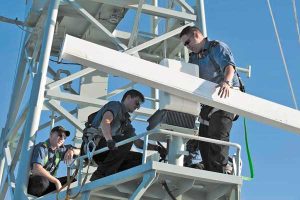Sailor puts skills to the test
By Lookout on Jan 13, 2014 with Comments 0

SLt Tyler Cole (centre) conducts routine preventative maintenance on the India Band radar with technicians MS Casey Clarke (left) and MS Nicolas Ferraro (right) on HMCS Protecteur.
A lot can change in seven weeks, as members of HMCS Protecteur learned during their recent task as the duty tanker for SOCAL Oiler 2013.
There were the usual challenges of maintaining a 44-year-old ship, which the crew was up to managing; however, half-way through the trip the Combat Systems Engineering Department had to think outside the box to keep the ship navigationally safe due to the degradation of India and Foxtrot Band radars.
While alongside San Diego, CA, SLt Tyler Cole, a Phase 6 Combat Systems Engineer (CSE), worked closely with the Logistics Department on board and at home in Esquimalt to procure and install a new X-Band Furuno radar.
SLt Cole was particularly interested in this assignment. “It’s not every day that I have the opportunity to be involved in such a big project,” he said.
He has been in the military for two years, but his interest and experience in naval engineering stems from his time as a session professor at Memorial University.
“I was completing my last year of my Masters in Ocean Naval Architectural Engineering under Dr. Wei Qiu in hydrodynamics. I taught Advanced Marine Ocean Vehicles and Marine Propulsion,” he explained.
Before returning to complete his Masters, SLt Cole worked as a Project Engineer at BMT Fleet Tech, where he worked on the Ice Breaking Emergency Evacuation Craft Project as a junior engineer. Once he finished his schooling, he then worked for the Sustainable Technology for Polar Ship Structures Project at Memorial University under Dr. Claude Daley and Dr. Bruce Colbourne.
As a CSE, SLt Cole has the opportunity to use his educational background to learn new skills and work at maintaining different pieces of equipment. In procuring the new radar, he developed the statement of requirements for the purchase, and then aided with the installation and assessment of the structural platform that was mounted on the ship, he said.
Installing the radar was relatively simple; however, there were some challenges because its integration with the ship’s inputs to the radar and some of the other systems had to be assessed.
“Also, with added platforms, it had to be assessed as structurally sound, and a new radiation hazard policy had to be temporarily set up to ensure the safety of the ship’s crew,” SLt Cole said.
The X-Band radar’s tracking capabilities are more accurate, and the radar picture is more detailed. It also ties directly into the Automatic Identification System, unlike the I-Band radar. The Officers of the Watch have easily adjusted to this new capability as it has an intuitive interface that makes it simple to use.
-SLt Noelani Shore, HMCS Protecteur
Filed Under: Top Stories
About the Author:





